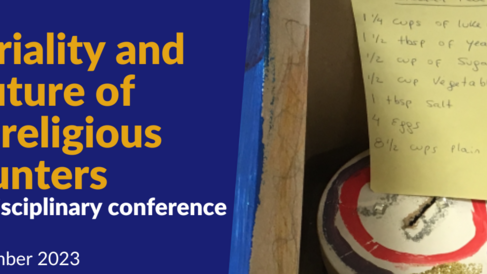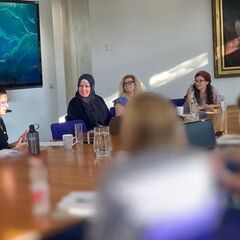
Over two days in September 2023, the Faculty of Divinity and Cambridge Interfaith Programme hosted the conference “Materiality and the Future of Inter-Religious Encounters”—convened by Dr Anastasia Badder (Cambridge) and Dr Lea Taragin-Zeller (HUJI). They reflect on the event:
Our aim was to examine the vital role of materiality in inter-religious encounters, highlighting the importance and potential of attending to the materiality and embodied nature of interreligious experience. In particular, the conference asked two questions:
- What might be learned by paying attention to the materiality of interreligious encounters?
- How do material elements—from buildings to food to bodies—enable interreligious relations, shape the texture of those relations, and facilitate respect and care?
Much like the study of religious life, research and practice related to inter-religious meetings has traditionally been oriented around language, discourse, and, especially, dialogue. At this conference, we heard from speakers whose work clearly shows that material things, spaces, objects, bodies, and beyond are critical actors in the production of inter-religious encounter, religious difference, and religion as a category, experience, and way of being.
A material beginning
The conference opened with a visit to the Cairo Genizah, housed at the University Library, where speakers were given the opportunity to view selections from the Genizah collection. These texts and the story of the Genizah itself set the tone for the discussion over the next two days by allowing speakers to engage with material manifestations of long-term historical interreligious relations. It reminded speakers, most of whom work with contemporary communities and contexts, that interreligious relations have not only occurred throughout history, but have always been complex, polyvocal, and perhaps less or differently politicized across contexts.
Following the Genizah tour and after a shared lunch, the conference opened with an introduction from the convenors. Professor Birgit Meyer (Utrecht) then gave a keynote lecture. Meyer is a major voice in the material turn in the anthropology of religion, and her lecture provided a powerful framework. Discussions about ‘interstices’, everyday moments of interreligious encounter, and the quotidian ways people of different religious traditions negotiate shared spaces, practices, and material exchanges carried across the conference.
Social media
Subsequent panels each focused on a specific modality of encounter. The first revolved around media, especially social media. Dr Samuel Everett (Southampton) chaired presentations from Ayala Fader (Fordham), Fatma Sagir (Albert-Ludwigs) and Emanuelle Degli Esposti (Cambridge).
Social media is often thought of as an ephemeral or immaterial thing. Yet there was a consensus that it acts on the material world: physically affecting those who engage it, articulating with material practices and religious moralities, and evoking tensions and ‘real world’ debates within and between religious communities. Equally, speakers demonstrated how social media enables new and unexpected alliances that could not manifest ‘offline’ between religious communities, such as those between conservative Christian bloggers and ultra-Orthodox Jewish women.
Climate and change
The second panel, chaired by Professor Esra Özyürek (Cambridge), centred on ecologies. Anastasia Badder (Cambridge) and Hanane Benadi (LSE) explored how religious groups grapple with climate change, its immediate and future effects, and its causes. A common theme that emerged from both talks was how concerns about climate change—and perhaps especially the process of dealing with its symptoms, such as skyrocketing temperatures and drought—act as nodes of encounter. Different religious communities intersect and negotiate their perspectives, desires, motivations, and visions of the future. Both talks pointed towards the potential of climate action to bring religious communities into co- or parallel action, as well as the potential for novel ideas about addressing climate change to emerge.

Intimate and political
At the end of the first day, speakers and attendees were invited to join a book launch for conference co-organiser Lea Taragin-Zeller’s new monograph: The State of Desire: Religion and Reproductive Politics in the Promised Land. Featuring a brief presentation from the author, and responses from Ayala Fader and Esra Özyürek, the event offered a powerful impression of Taragin-Zeller’s research.
The audience heard how an accidental moment of eavesdropping on conversation between two young women led to the full-length study. Through interviews and analysis, the book itself explores how religious families negotiate with institutional actors, state policies, and doctrine as they make highly personal decisions about reproduction and fertility.
Most relevant for conference attendees, the discussion reminded participants to consider the multiple scales across which inter-religious encounters are shaped and take place from the political to the intimate, and the layered nature of such encounters. A dinner at Lucy Cavendish College offered an informal setting at which to debrief about the day’s discussions and learn more about each other’s work.
Sensory encounters
The conference resumed on Friday with a panel focused on senses and sound. Papers from Vlad Naumescu (Central European University), Erica Weiss (Tel Aviv), and Samuel Everett (Southampton) spanned a wide range of contexts from a Christian ashram to Muslim–Jewish relations in France. A series of key questions emerged:
- What is the intersection of aesthetics and ethics in inter-religious encounters? How are atmospheres co-created, transmitted, or broken?
- Who determines their contours and how do others resist?
- How are atmospheres transmitted?
Lively discussion was sparked—about taking atmospheres and aesthetics seriously as dimensions of diverse religious people meeting.
Shared space and memory
Panel four focused on space, with an appropriate hybridity—the speakers joined over Zoom. Safet HadźiMuhamedović (Cambridge) explained how stories fill the gap left by ruptured material encounter in the Bosnian highlands, while Jeremy Walton (Rijeka) contrasted sites in Turkey and Croatia. With these two visions of the role of space in inter-religious encounter, the audience was invited to think about how memories of shared spaces are brought into contemporary moments in ways that can either erase or revitalize religious pluralities.
More broadly, these papers reminded the audience that while we can acknowledge the process by which subjects make objects make subjects (Pinney 2005), this relationship and the path along which it proceeds is not always linear or obvious. Interactions between different religious communities and/in shared spaces can have disruptive and unpredictable outcomes. That is, the sharing of space does not automatically lead to clear cut harmony or antagonism, but rather to something complex, layered, and shifting.
Bodily and fluid
Our fifth panel focused on bodies and the state. Ben Kasstan (London School of Hygiene and Tropical Medicine) and Lindsay Simmonds (LSE) approached the theme from very different contexts and angles: Kasstan examined the experience of Muslims and Jews in Britain and their construction as ‘Orthodox fraternities’—strategically and organically created by various stakeholders (including the state) in the face of new statutory laws around sexuality education. Simmonds explored the textures of relations that emerge as the same human bodies come together in different kinds of political and physical spaces, especially in relation to peace building.
Both papers powerfully illustrated the dynamism and rhizomatic nature of inter-religious encounters: such relations are not formed and then fixed, but rather are fluid and may appear or feel different or enable different kinds of actions from different angles and within different contexts.
From past to future
The final panel of the conference centred on time. Featuring talks from Yulia Egorova (Durham) and Emily Hanscam (Linnaeus), this panel explored how past, present, and future are materially manifest, articulated, collapsed, and mutually imbricated in and through encounters between minority and majority religious communities.
Egorova addressed how representations of Jewish heritage in the English town of Lincoln feature in inter-faith settings, while Hanscam shared insights from interviews with archaeology students about the intersection between their fieldwork in Halmyris (Romania) and its role as the focus of an annual Orthodox pilgrimage. Together, these papers invited the audience to consider the ways in which multiple pasts are materialised and continue to shape present relations and projected futures.
New insight
As the conference drew to a close, speakers were invited to reflect on the discussion and share their biggest takeaways. The following insights emerged:
- The realisation that inter-religious encounters are always already materially grounded and inflected.
- The potential of a focus on materiality to decentre religious texts which are often centred in planning for and talk about interreligious encounters and which tend to privilege gendered traditions of knowledge production.
- The nuanced proximities and coexistences that surfaced through a focus on the material, despite long-standing highly politicized religious divides; and conversely
- The power dynamics, assumptions, and disconnects shaping organised encounters that are often figured as peaceable meetings between equals; and lastly,
- The possibility of rethinking—and thus re-doing—prevalent ideas and formats of religion and religious exchange that have largely emerged from strongly Protestant legacies.
Conference participants speculated about ways these insights might help us to imagine novel ways for understanding and, importantly, facilitating inter-religious encounter.
Where next?
There was strong interest in continuing the conversations. Our first step is to work on a special issue, which we hope will appear in late 2024. Further steps may include a further event in 2024, co-organising a roundtable at a larger conference next year, and/or potentially creating a research network.
The conference was funded jointly by the Spalding Trust and the Faculty of Divinity, in association with the Cambridge Interfaith Programme.
